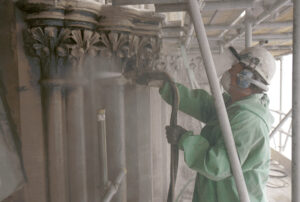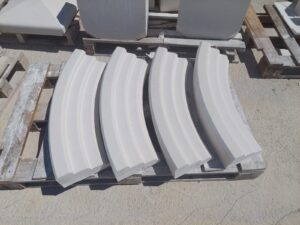Turkish stone is a unique building material that enhances the beauty and elegance of home and villa facades. Prominent types of Turkish stone include Turkish Travertine and Limra Stone, widely used in designing and installing exterior facades. Turkish marble is also used in many global projects, such as the Grand Mosque in Mecca and the New York City Subway. This remarkable material offers endless design possibilities to add a special touch to your home. Here are some tips to achieve outstanding results:
1. Correct Stone Selection:
- Check Stone Quality: Before purchasing, ensure the stone’s quality and strength. Choose high-quality stone that is resistant to environmental effects.
- Design-Based Selection: Select stone that matches the overall design of the facade and the surrounding environment of the house.

2. Preparing the Surfaces:
- Surface Preparation: Make sure to clean and level the exterior surfaces to ensure a smooth and durable installation.
3. Proper Installation:
- Stone Preparation: Before installation, prepare the stone properly to ensure it fits perfectly with the facade.
- Using Cement: Use suitable cement or adhesives to securely fix the stone.
- Hidden Fasteners: Along with cement, use internal, non-visible fasteners to ensure the stone remains attached to the wall and does not fall due to weather conditions like humidity and heat.
- Mechanical Installation: If you prefer mechanical installation, use high-quality stainless steel brackets to prevent rust and deterioration.
4. Spacing:
- Using Spacers: Place spacers between stones to control distances and ensure even distribution, achieving a cohesive and integrated appearance.
5. Maintenance:
- Stone Care: Follow proper maintenance guidelines to preserve the beauty and durability of the stone over time.

6. Beauty and Design:
- Design Coordination: Choose a design that matches the overall facade of the house and the exterior decor.
- Ornaments and Design: Use stone to add various ornaments and patterns, giving a unique aesthetic touch to the facade. For classic designs like columns, cornices, arches, and decorations, use intricate details. For simpler designs, install plain stone mechanically to enhance the facade’s beauty.

7. Safety:
- Safety Standards: Ensure the stone installation complies with local safety and building standards.
- Slip Prevention: If using stone in areas exposed to rain, consider selecting non-slip stone to prevent accidents.

8. Lighting:
- Proper Lighting: Use lighting to highlight the beauty of the stone at night and create an enchanting atmosphere for the facade.
- Economic Lighting: Use energy-saving LED lights to enhance the stone’s beauty and save energy.

9. Consulting Professionals:
- Architectural Consultation: Consider consulting with architects or designers to help choose and design the installation more effectively.
- Expertise of Kurabi Marble: Benefit from the expertise of Kurabi Marble in selecting the best options for your facade and receiving suitable design and ornament recommendations.
In summary, installing Turkish stone on exterior facades can add a unique and luxurious aesthetic touch to your home. Attention to detail and good planning ensure the installation is both durable and beautiful.

